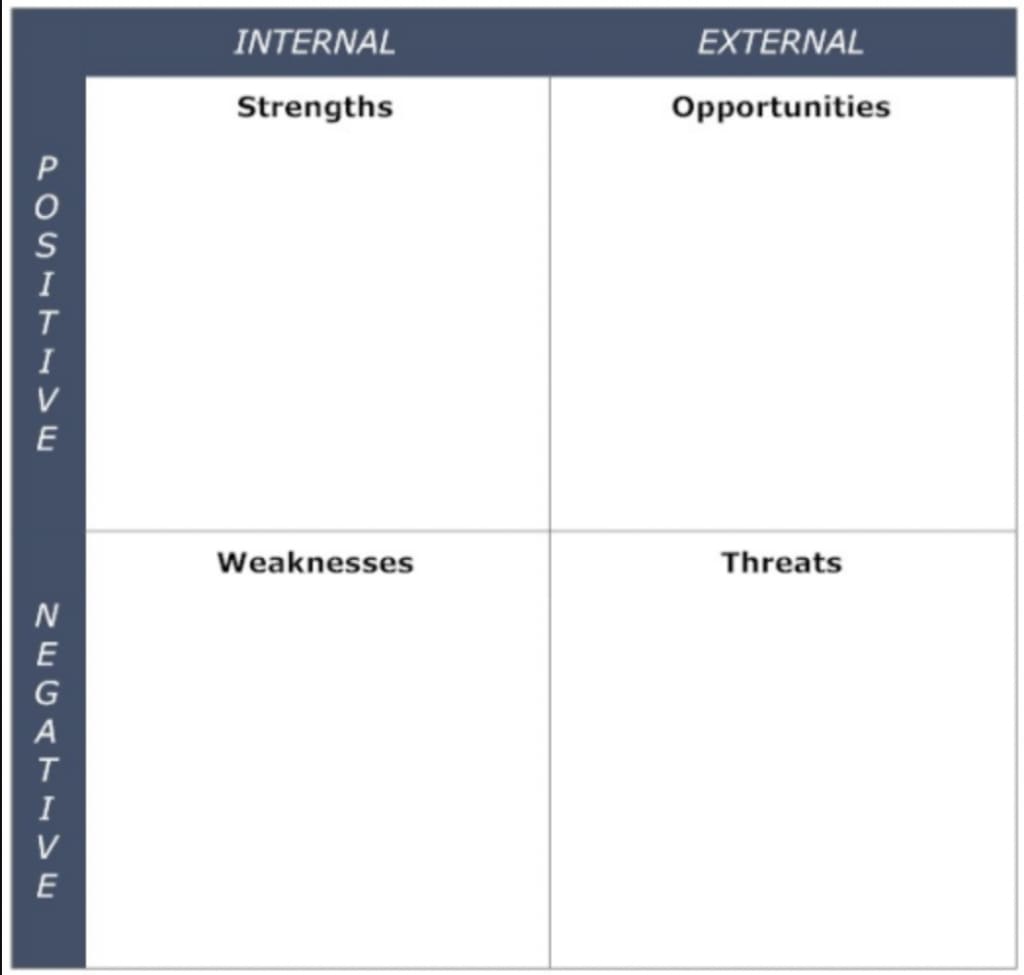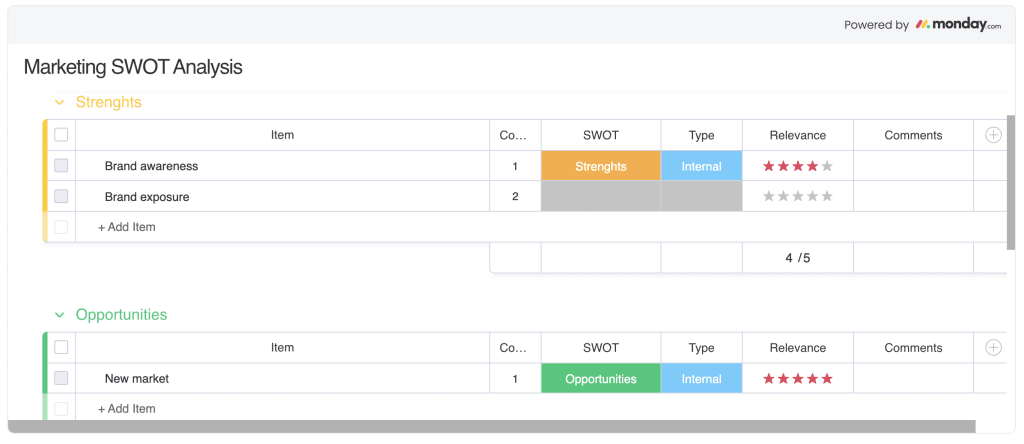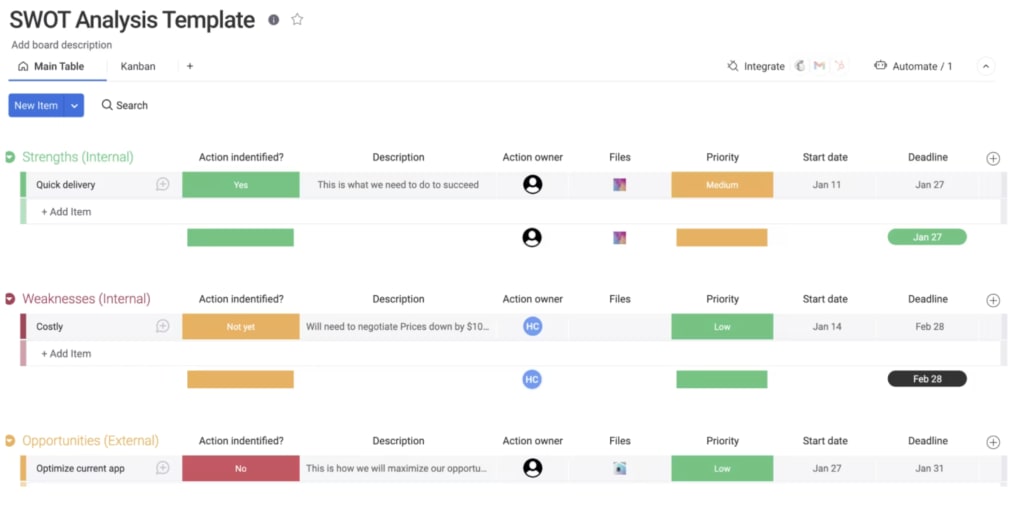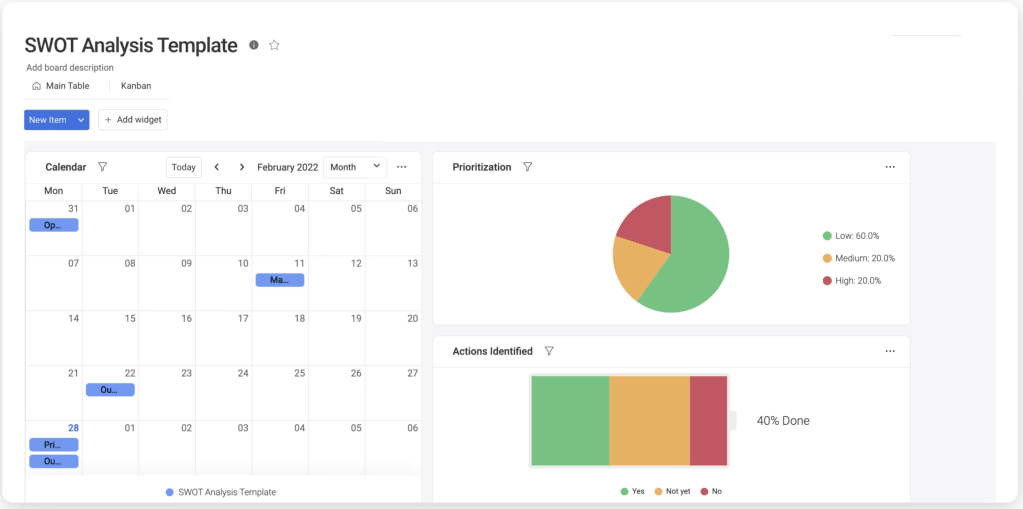Project management is an ever-evolving field that requires a thorough understanding of various methods and techniques to ensure the successful completion of projects. One of the key elements of project management is conducting a SWOT analysis.
A SWOT analysis in project management is a tool used to assess the various aspects of a project before its implementation. This analysis provides organizations with essential information about where projects are likely to succeed or fail so that teams are aware of their strong points and faults before starting on a project.
To help you better understand how to conduct a SWOT analysis for your own projects, we’ve broken down what goes into the process, some tips to get the most out of your analysis, and how monday.com can help you put it all together.
What is a SWOT analysis in project management?
SWOT analysis in project management is a method that’s used to assess a project’s strengths, weaknesses, opportunities, and threats. It helps stakeholders identify which areas of a project to focus on as well as potential risks to address in advance.
Running a SWOT analysis helps project managers and stakeholders identify impacts on a project’s success while simultaneously developing strategies that can improve a project’s outcomes.
Benefits of a SWOT analysis
Conducting a SWOT analysis can help when you’re at the starting point of a project. It can also help project managers optimize planning and efficiency by staying aware of potential threats and weaknesses. Running a SWOT analysis can also benefit an organization in several ways:
- Identify strengths and weaknesses associated with your project so that you can focus on areas needing improvement
- Find potential threats that may arise in order to make well-informed decisions
- Improve collaboration by bringing people together to discuss how to approach a project
- Simplify the brainstorming process by establishing a shared understanding of a project’s current state
- Inform the strategic planning process by creating a framework for analyzing a situation and making future plans
How to conduct a SWOT analysis
Before you begin your SWOT analysis, it’s important to know how to organize the information. There are several ways of doing it, but one of the most common is to break down the information into a grid that looks like this:

What’s most important in creating your SWOT analysis breakdown is that the information is presented in a clear visual way so that all stakeholders can easily understand it. If you don’t want to make your own grid, there are project management software tools like monday.com that offer SWOT analysis templates you can use for collaborative visualization of your data.
Let’s look at a more detailed breakdown of what data to look at in each section of a SWOT analysis. This will help you perform your own analysis without missing out on any important information.
Strengths
Strengths refer to the internal factors within a company that gives it an advantage over competitors. These can include a strong brand, a loyal customer base, good employee relations, efficient operations, financial stability, and access to resources. In this part of a SWOT analysis, organizations are identifying their strongest assets.
Weaknesses
On your SWOT analysis chart or software, weaknesses is where you list the internal factors that might negatively impact a project’s success. Possible weaknesses could be new or untrained team members, not having the right resources, a limited budget or timeline, or a lack of communication tools.
Opportunities
Opportunities are external factors that can be leveraged to help a business reach its goals. These factors are outside of an organization’s control but can lead to positive impacts on a project. Examples of opportunities may include a growing market, new technology, access to resources, and favorable economic conditions.
Threats
Threats are external factors that would have a negative impact on an organization’s performance if they were to take place. Examples of threats in a SWOT analysis include unforeseen changes to your supply chain, changes in technology, price increases from vendors, or even an economic downturn.
Tips for doing your own SWOT analysis
The results of your SWOT analysis will only be as good as how prepared you were to gather the information. Planning ahead and knowing what to look out for in this process will help you in gathering the right information on which to base your decisions so that you can take the best course of action for your business. Here are some tips to consider when running a SWOT analysis:
- Start by gathering the right people: Invite a diverse group of stakeholders to the SWOT analysis meeting, including team members, customers, and industry experts.
- Set an agenda: Have a clear agenda that outlines the purpose of the meeting, the timeline of the SWOT analysis, and an overview of the process.
- Brainstorm solutions: Once you have identified the strengths, weaknesses, opportunities, and threats, brainstorm potential solutions and strategies to address each item.
- Prioritize factors: After the team finishes brainstorming, organize the factors in each category from most to least important so everyone is on the same page about priorities.
- Assign tasks: Assign tasks and responsibilities to members of the group for implementing the solutions.
- Follow Up: Follow up with the group after the meeting to ensure that tasks are being completed and strategies are being implemented.
Running your SWOT analysis on monday.com
A SWOT analysis should be a collaborative process between all stakeholders in a project. To ease the communication and brainstorming, turn to project management software like monday.com to contain all elements of your analysis in one place. Here’s how it can help.
Easily visualize your SWOT analysis

With a dedicated SWOT analysis board, you can easily list different strengths, weaknesses, opportunities, and threats. You can prioritize each item and sort them by relevance, add comments, files, and task owners.
Seamless collaboration

monday.com project management makes it easy for teams to collaborate on the SWOT analysis process. If your team works remotely or isn’t able to meet physically, changes are instantaneous, allowing all stakeholders to brainstorm with ease and then align on tasks.
Data-driven insights

Once your SWOT analysis is complete, you can import data from external sources, such as an Excel sheet, in order to make business decisions based on concrete data. Having the analysis and resulting data all in one place helps keep your projects transparent and simplifies planning.
FAQs
How do you do a SWOT analysis for better strategic planning?
The method for doing a SWOT analysis for strategic planning is the same as any other SWOT analysis. You need to first identify the strengths, weaknesses, opportunities, and threats of an organization and then use the information gathered to develop strategic planning strategies.
How does a SWOT analysis help project management?
A SWOT analysis provides an overall view of the project and helps identify potential risks and opportunities, allowing project managers to develop strategies and actions to help ensure a project’s success.
What is the main purpose of a SWOT analysis?
The main purpose of SWOT analysis is to identify the strengths, weaknesses, opportunities, and threats of a business or project. It is a tool used to evaluate the overall viability of a venture and to gain an understanding of the internal and external factors that may influence its success.
Make your next SWOT analysis the most impactful yet
By conducting a SWOT analysis, businesses can gain a better understanding of their industry and develop strategies that maximize their strengths while minimizing their weaknesses. A SWOT analysis is a great starting point to help businesses achieve their goals, but it needs to be done in an organized way to remain effective. monday.com helps teams ensure the success of their SWOT analysis by providing a collaborative platform for all stakeholders to participate, view gathered data, and keep track of action plans.
